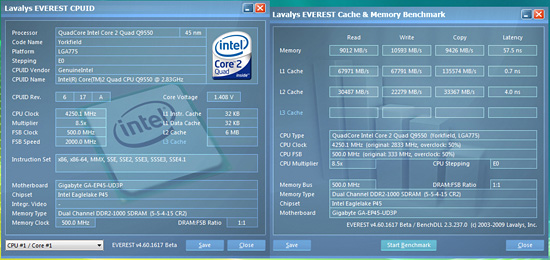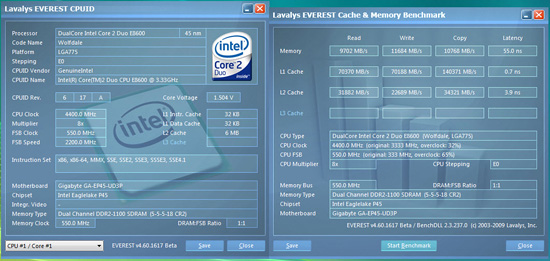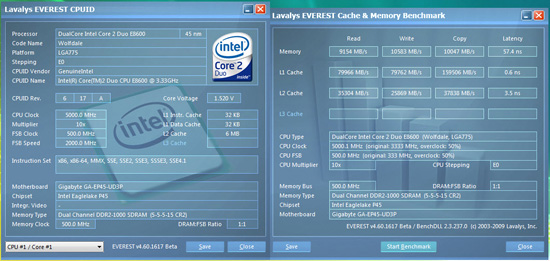Gigabyte GA-EP45-UD3P - P45 at its Finest
by Gary Key on February 3, 2009 12:15 AM EST- Posted in
- Motherboards
Overclocking
GIGABYTE advertises the GA-EP45-UD3P as a mainstream motherboard and will nudge users towards their enthusiast-oriented EP45 Extreme series or X48 boards for overclocking duties. We are here to say that is a big mistake based upon our results. We expected solid overclocking based on the BIOS design and board components, but this board clocked just as well or better than any upper-end P45 or X48 boards we have in the labs.
True, there are boards that might hit higher FSB rates or offer better memory performance, but we are concentrating on mainstream overclocking abilities in our tests. We focus on the type of overclocks that support 24/7 operation with reasonable cooling and the ability to run a multitude of programs without a problem. We are not optimizing for SuperPI or 3DMark records; it's more like trying to keep our bank records safe from a crash (sadly, there's nothing we can do about banks crashing).
We put an emphasis on stability during our testing sessions so we test with real world applications ranging from a variety of games to digital imaging software to various audio/video creation programs, along with the normal OCCT and PCMark Vantage tests.
Q9550 4GB Results

Our maximum overclock on air-cooling with the Q9550 resulted in a 4.25GHz clock speed at a respectable 500MHz FSB with our 4GB G.Skill memory kit set to DDR2-1000 at 5-5-4-15 timings. The primary voltages settings were 1.36V NB, 1.38V VTT, 1.70V PLL, 2.00V VDimm, and 1.425V for the CPU. We tried to run the memory higher, but could not get stability at the DDR2-1200 mark in Nero Recode or Crysis. Vdroop was approximately -.02V with Load Line Calibration (LLC) enabled and -.035V with it disabled at idle. Under load Vdroop was -.025V with LLC enabled and -.05V with it disabled.
Q9550 8GB Results

We were able to reach the same 8.5x500 for a 4.25GHz clock speed with 8GB at DDR2-1000 with 5-5-5-15 timings. However, our voltage settings changed to 1.38V NB, 1.40V VTT, 1.70V PLL, 2.06V VDimm, and 1.450V for the CPU to compensate for the additional load on the MCH. Under load Vdroop was -.02V with LLC enabled and -.05V with it disabled.
E8600 Results

Our maximum overclock on air-cooling with the E8600 came with a blistering 4.40GHz clock speed at a fully stable 550MHz FSB rate. Our 4GB G.Skill memory kit allowed us to reach DDR2-1100 at 5-5-5-18 settings. We used the following voltage settings: 1.40V NB, 1.36V VTT, 1.72V PLL, 2.08V VDimm, and 1.500V for the CPU. We had to drop to 8x500 to get 8GB stable while keeping VDimm below 2.1V, PLL below 1.80V, and NB below 1.50V. Vdroop was approximately -.01V with Load Line Calibration (LLC) enabled and -.025V with it disabled at idle. Under load Vdroop was -.02V with LLC enabled and -.04V with it disabled.
E8600 Additional Results

We knew we had a good E8600, so we pulled out our CoolIT Systems Freezone Elite kit and decided to see how far we could get on this board. We ended up at 5GHz with a 10x CPU multiplier and FSB set to 500. We installed 8GB of memory and ran it at DDR2-1000 with 5-5-5-15 timings. We used the following voltage settings: 1.42V NB, 1.40V VTT, 1.76V PLL, 2.04V VDimm, and 1.5675V (1.550V was stable after raising NB to 1.46V) for the CPU. This is the first time we have reached a stable 5GHz with this processor in a P45 board. Vdroop was similar to our results above.
Thoughts
We have absolutely no concerns about recommending this board for 24/7 500FSB+ use. This board overclocks quad-core chips just as easily as it does dual-core offerings, which is a feat that most P45 boards cannot accomplish. Depending on your processor choice, the Northbridge (MCH) and PLL voltages are two prime settings open for reduction. We only utilize retail processors so it is up to luck if we get a good processor or not for overclocking.
We ultimately ran our E8600 at 585FSB stable in all our applications except for Adobe Premier Pro 4.0; it would constantly hang at any FSB setting above 550. We also tried to verify GIGABYTE’s claim of DDR2-1366 support but our 2GB DDR2-1250 memory kit was unable to get above 1300. However, this is the first board that ran it stable at 1300 so we think it is just a limitation of our memory kit - or reluctance to push more than 2.4V into it.
In regards to voltage regulation, we think the GA-EP45-UD3P has excellent voltage output. We checked all the major voltages with a DMM and found very little variance between what you select in the BIOS and what the board actually outputs. The VTT, PLL, DIMM, and other voltages are accurate and stable across the spectrum. They show no real variances between idle and load states; if anything, we would see a small +.005V rise at times. As discussed, there is line droop on VCore when switching from idle to load situations. However, we found it was not substantial enough to affect stability or overclocking capabilities.
















73 Comments
View All Comments
Archeon - Tuesday, February 3, 2009 - link
I've used this board in my main rig now for about two months. I found this board has ONE major downside, which is not mentioned in this review I think.The problem is this: there is one electronics component VERY close to one of the holes which is used to hold to cooler onto the board. You can see the component I mean when you look at the second pic on page 4 (board layout) of this review. It's the hole surrounded by all the caps. If you look closely, you'll see that right above this hole, there's some sort of flat, slightly elevated electronics component.
Why is this a problem? Because this hole is preventing me from mounting about any other cooler than the stock Intel cooler! I've tried both a Scythe Infinity (Mugen) and Ninja. I simply cannot install these coolers without pushing off the electronics component, which surely would not be a good idea. Even the stock Intel cooler of my old E6600 CPU doens't fit!! (Luckily the stock cooler of my E8500 does!)
So now I run my rig with the stock Intel cooler, which is a shame since I have such a nice Mugen cooler readily available here, but it just won't fit!!! This is bad board design INHO, nothing less, nothing more.
Apart from this issue, I absolutely love this board: rock solid, and all the features I need (and then some!)
The0ne - Tuesday, February 10, 2009 - link
Looks like an oscillator to me and it does appear to sit too close to the locking hole. However, the photo might be deceiving my eyes. But judging from the pics alone I'm pretty sure my Artic Freezer 7 fan wouldn't fit on there. The clips will hit the component as well. However, my fan does sit fine in my EP45-DS3R but it's a bit different board.7Enigma - Tuesday, February 3, 2009 - link
Hmm, that is odd as the reviews seemed to say that most of the common high-end coolers had no problem. I have the Xigmatech 120mm Rifle cooler and it installed with no clearance issues (pushpin pieces of $hit are another story). Is it that you want to mount the cooler in a specific orientation and it won't work, or that there is no way that any direction would work?Archeon - Wednesday, February 4, 2009 - link
No specific orientation. It didn't work in either way. I even bought [url=http://www.scythe-eu.com/en/products/pc-accessory/...">http://www.scythe-eu.com/en/products/pc-accessory/...]Scythes CPU Cooler stabiliser[/url] in the hope that would work, but again, no go...LoneWolf15 - Tuesday, February 3, 2009 - link
and I have to say, this board is the best I've ever owned. Tons of features and ports, (including two PS/2 ports for you KVM users, yes, I'm talking to you ASUS) a great layout, loads of BIOS options, rock-solid stability --about the only things I could nitpick about are Gigabyte's funky color scheme, and perhaps not having right-angle front-mounted SATA ports. Both very minor details. It's working well with two 4GB DDR2 modules and a Q6600.I'd recommend this board to anybody, it's a quality part. Thanks for the review, AT.
7Enigma - Tuesday, February 3, 2009 - link
I just built a rig using the R (single GPU) mobo and have had some problems upgrading my rig from an old 80gig PATA drive to a new 320gig SATA drive. Here is my problem:-I installed Vista 64bit on the new rig with my old 80gig drive and then decided I wanted to rebuild my old rig (replaced everything but case and HD) using the old drive. I need to clone my 80gig onto my 320gig so I can swap the old drive out. Problem is when I connect the SATA drive using the 90 degree elbow SATA cable that says HD, it is not recognized in windows. I can find it in the device manager, and it says it is working properly, but there is no way to copy/format/etc. to it?
I've tried using both the 6 orange SATA ports, and also the 2 purple ports (I don't know if there is a difference here or not), but no luck. Should I try a no 90degree elbow cable? I'm unfamiliar with SATA tech and so wonder if the 90degree cable designates the SATA drive as master, and I need to have it as a slave? When I go into the bios BOTH drives come up as MASTER, but seem to be on different channels so I didn't think this was an issue.
Sorry to take this off topic but I spent a couple hours this past weekend and got nowhere.
I have another issue that seems to be related to some power saving thing with this board. Before I turned off the power saving features in the bios it would seem to randomly not like to start from a cold boot (I'd have to turn it off and on, or restart if it got to the bios screen). It almost seemed like it was cutting power too quickly on shutdown and startup. Most of the issues seem to have gone away since I turned off the power saving functions, but I still get some squirly things happening when turning on for the first time. I'm currently using optimized defaults in the bios so it's not a wierd overclocking issue.
Thanks for the advice.
7Enigma - Tuesday, February 3, 2009 - link
Wanted to mention this is with the latest chipset drivers and the F7 bios. I LOVE the online bios update. No more floppy flashes for me!Mr Roboto - Sunday, February 15, 2009 - link
Yeah, that's an old Gigabyte feature. When I used it on my old AMD based GA-K8U-939 it worked flawlessly then. People rip on Gigabyte's BIOS support and complain about bad flashes but I've NEVER had any of those problems with them.However on less popular boards BIOS support is slow.
Glenn - Tuesday, February 3, 2009 - link
I suggest you review the owners manual and make sure which SATA controller you are connected to and ensure that it is properly set in the bios for your configuration. I suspect you have whichever controller you are connected to, to AHCI or Raid and it isn't recognized. I know it's confusing until you get used to it, but SATA doesn't use the old master slave ...!7Enigma - Tuesday, February 3, 2009 - link
Wanted to also add I tried both the G-SATA (purple connectors) and the standard orange Intel ones with no effect. It wasn't until I quit and removed the SATA drive that I thought to try the non 90 degree elbow one that says HDD on the cable. Can you comment on whether there are specific SATA cables that denote HD's or whether they just had the 90 degree bend to facilitate placement in the case without stressing the connectors (I have read many complaints on breaking off).